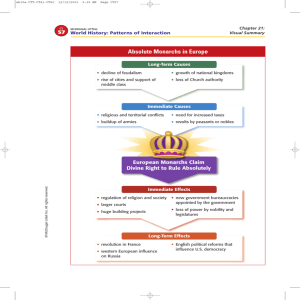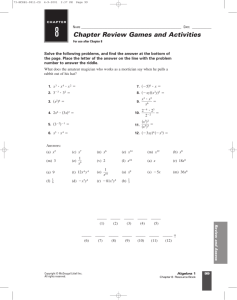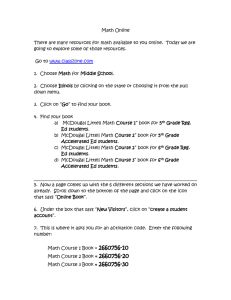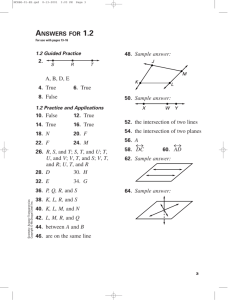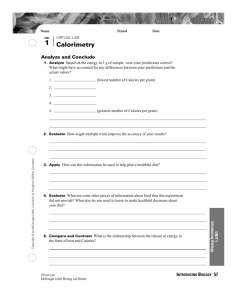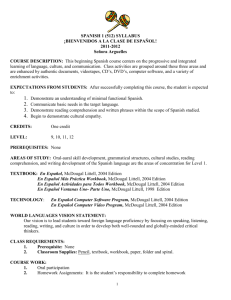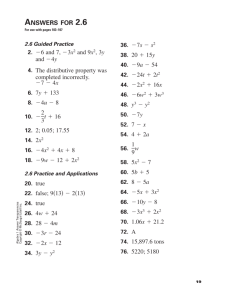United States History – Reconstruction to the Present
advertisement
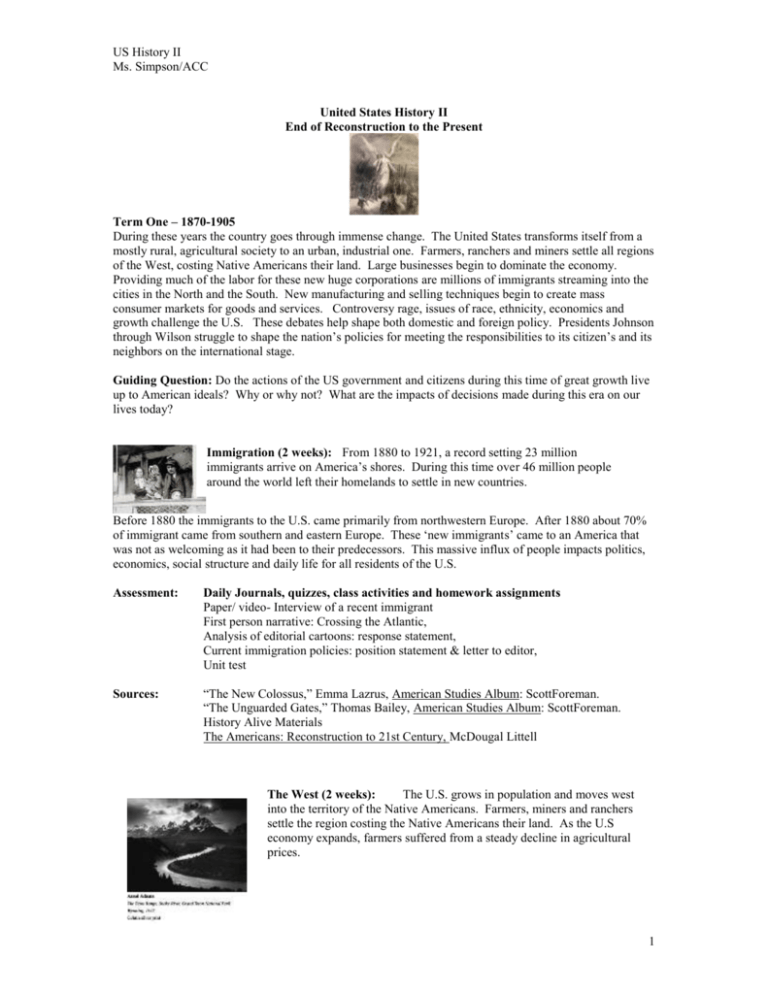
US History II Ms. Simpson/ACC United States History II End of Reconstruction to the Present Term One – 1870-1905 During these years the country goes through immense change. The United States transforms itself from a mostly rural, agricultural society to an urban, industrial one. Farmers, ranchers and miners settle all regions of the West, costing Native Americans their land. Large businesses begin to dominate the economy. Providing much of the labor for these new huge corporations are millions of immigrants streaming into the cities in the North and the South. New manufacturing and selling techniques begin to create mass consumer markets for goods and services. Controversy rage, issues of race, ethnicity, economics and growth challenge the U.S. These debates help shape both domestic and foreign policy. Presidents Johnson through Wilson struggle to shape the nation’s policies for meeting the responsibilities to its citizen’s and its neighbors on the international stage. Guiding Question: Do the actions of the US government and citizens during this time of great growth live up to American ideals? Why or why not? What are the impacts of decisions made during this era on our lives today? Immigration (2 weeks): From 1880 to 1921, a record setting 23 million immigrants arrive on America’s shores. During this time over 46 million people around the world left their homelands to settle in new countries. Before 1880 the immigrants to the U.S. came primarily from northwestern Europe. After 1880 about 70% of immigrant came from southern and eastern Europe. These ‘new immigrants’ came to an America that was not as welcoming as it had been to their predecessors. This massive influx of people impacts politics, economics, social structure and daily life for all residents of the U.S. Assessment: Daily Journals, quizzes, class activities and homework assignments Paper/ video- Interview of a recent immigrant First person narrative: Crossing the Atlantic, Analysis of editorial cartoons: response statement, Current immigration policies: position statement & letter to editor, Unit test Sources: “The New Colossus,” Emma Lazrus, American Studies Album: ScottForeman. “The Unguarded Gates,” Thomas Bailey, American Studies Album: ScottForeman. History Alive Materials The Americans: Reconstruction to 21st Century, McDougal Littell The West (2 weeks): The U.S. grows in population and moves west into the territory of the Native Americans. Farmers, miners and ranchers settle the region costing the Native Americans their land. As the U.S economy expands, farmers suffered from a steady decline in agricultural prices. 1 US History II Ms. Simpson/ACC Assessments: Daily Journals, quizzes, class activities and homework assignments Impact Statements: Examination of primary accounts from Native Americans who lived in the late 19th century. Compare and Contrast primary sources: How should Americans treat the land? Chief Seattle and Theodore Roosevelt First person Narrative: Battle of Little Big Horn, 250 words American Patriots, Buffalo Soldier reading: Who fought these Wars? You’re a farmer now. Can you make a profit as a farmer in Nebraska? “Raise less corn and more hell” compare and contrast primary sources from the Populist movement. Unit test Sources: The Americans: Reconstruction to 21st Century, McDougal Littell History Alive materials, American Patriots: the Story of Blacks in the Military from the Revolution to Desert Storm, By Gail Buckley White Man’s Image, American Experience, PBS The Black West, William Loren Katz “Dick Fool Bear Remembers Wounded Knee,” American Studies Album: ScottForeman. “Critic of the Populist” by E.L Godkin, The Nation “Raise less corn & more hell” Mary Lease Speech: American Studies Album: ScottForeman. Rise of Industry (2 weeks): Technological innovation and the growth of the railroad industry helped fuel an industrial boom. Some business leaders follow corrupt practices and workers suffering harsh working conditions try to organize unions. The Progressive movement urges political and social reform. Assessments: Daily Journals, class activities, quizzes and homework assignments First person narrative: Triangle Shirt Waist, 250 words Child Labor: Photo Analysis Current Labor Conditions – Fast Food Nation: Reaction paper Progressive Era Debate and Press Conference Compare and contrast primary sources: Has Industrialization produced more benefits or more problems for the nation? Andrew Carnegie’s “Gospel of Wealth” and Henry George’s “Progress and Poverty” Sources: The Americans: Reconstruction to 21st Century, McDougal Littell History Alive materials, Excerpts from The Jungle, by Upton Sinclair Excerpts from Triangle; The Fire that Changed America, by David Von Drehle Excerpts from Fast Food Nation, by Eric Schlosser “Gospel of Wealth” by Andrew Carnegie “Progress and Poverty” by Henry George 2 US History II Ms. Simpson/ACC Life at the Turn of the 20th Century (1.5 weeks): Advances in science and technology address urban problems and enhance living condition for those who have access to these innovations. The push for progressive reforms, the need for an educated workforce and to “Americanize” new immigrants leads to changes in education. African Americans lead fight against institutionalized racism. Many Americans have more leisure time and a modern mass culture emerges. Assessments: Daily journals, quizzes, class activities and homework assignments Examination of Plessy v. Ferguson (1896) Controversy in education: compare and contrast views American entertainment: American culture and attitudes – research and presentation First person narrative: How will the latest technology change your life? 250 words Term Paper: What were three factors that contributed to the rapid growth of industrialization in the United States at the end of the 19th century and what was the particular impact of each? Sources: The Americans: Reconstruction to 21st Century, McDougal Littell Facing History materials Term Two - 1890 - 1920 The United States claims an empire and enters the world stage. During this time President’s McKinley, Roosevelt, Taft and Wilson are forced to develop active foreign polices that send American soldiers from the West into the rest of the world. Imperialism (3 weeks): The late 1800s are often referred as the Age of Imperialism. European nations carve up much of Africa and parts of Asia and the Pacific. The United States joins in this pursuit in the Caribbean, Central and South America, the Pacific and Asia. Perceived technological, ethnic and moral superiority spurs imperialism at the turn of the 20th Century. As the States acquires new territories, questions were raised about the civil rights of the people in these lands. Guiding Questions: Background: From 1890-1920, the United States government was faced with four foreign policy positions: isolationism, collective security, internationalism and imperialism. Question: What was one way the United States government employed each of the following foreign policy positions from 1890 to 1920: isolationism, collective security, internationalism and imperialism? Which principles of our Constitution or Bill of Rights does the United States foreign policy around the turn of the century articulate? How? How is the US foreign policy of this era different or similar to the foreign policy of today? Assessments: Daily Journals, quizzes, class activities and homework assignments Presidential timeline Foreign Policy Spectrum – The US policy stances Yellow Journalism Article –300 words with illustration American Patriots; Buffalo Soldiers II – guided reading questions Visual Metaphors – US Interventions; research, create & present Compare and Contrast Primary Sources; 3 US History II Ms. Simpson/ACC William McKinley campaign speech & Albert Beveridge’s “The March of the Flag” Unit Test Sources: The Americans: Reconstruction to 21st Century, McDougal Littell History Alive materials American Patriots: the Story of Blacks in the Military from the Revolution to Desert Storm, By Gail Buckley World War One (3 weeks): As European tension erupts into war, the U.S. tries to remain neutral. American soldiers enter the brutal war and American society is in turmoil in meeting the demands of the war. Finally, at war’s end, President Wilson offers plans for world peace and Americans are determined to remove themselves from foreign affairs. Assessment: Daily journals, quizzes, class activites and homework assignments Eager Soldiers – examinations of primary accounts American Patriots ,WWI: guided reading and response questions First Person Narrative: Soldier’s life in the trenches, 300 words First Person Narrative: Citizen’s view: For or Against the War? 300 words Examination of War time Propaganda Negotiation of the Treaty of Versailles Unit test (Mid term) Sources: The Americans: Reconstruction to 21st Century, McDougal Littell History Alive Materials American Patriots: the Story of Blacks in the Military from the Revolution to Desert Storm, By Gail Buckley Facing History and Ourselves, Resource book Term Paper: Shifting U.S. Foreign Policy – Does the United States foreign policy around the turn of the century live up to American ideals? Why or why not? To what degree should we feel proud or ashamed of the actions of the American government and society during this time? 1000 words Term Three: 1920 – 1945 Americans weary of war seek a return to normalcy. In doing so, a national climate of anger develops that is directed towards those who are viewed as different or as radicals. The years of prohibition, depression and world war are challenging for the nation. Issues of religion, race, loyalty and national security dominate the debates of the day. Guiding Questions: These three decades are considered to be the best of times and the worst of times for the U.S. Do you believe that the roaring 20’s were really roaring? Were the Great Depression and WWII inevitable? What steps could have been taken to avoid these global catastrophes? The Roaring 20s….really? (2 weeks) The 1920s are a time of great changes in the nation. Controversy rages in labor issues, government corruption, religion, science, race, and politics. Prohibition outlawed the sale of alcohol. Harlem attracted some of America’s finest artists. Consumer products flood the markets and buying on credit is common. 4 US History II Ms. Simpson/ACC Assessments: Daily journal, class activities, quizzes and homework assignments Analysis of primary documents from the Women’s Suffrage Mv’t Analysis of Vanzetti’s speech to jury Debate with Lucy Stone – 300 words Harlem Renaissance Museum Exhibit – research, create & present 300 words. Sources: The Americans: Reconstruction to 21st Century, McDougal Littell History Alive materials Our Mothers Before Us: Women and Democracy, National Archives. The Great Depression (2 weeks): The economic boom of the 1920s collapses in 1929 as the U.S. enters a deep depression. Millions of Americans lose their jobs and homes. President Hoover is unable to end the downslide. President Roosevelt launches a program aiming to end the Depression. The President’s New Deal has profound long-lasting effects on the nation. Assessments: Daily journal, class activities, quizzes and homework assignments Evaluation of 1920’ economic data: prediction statement First person narrative: Economic Realities of the Great Depression, 300 words Letter to Hoover: What should be done about the Great Depression, 300 words Letter to FDR: New Deal or Raw Deal? 300 words Evaluation of New Deal Programs: Modern Impact Evaluation Statement Unit test Sources: The Americans: Reconstruction to 21st Century, McDougal Littell History Alive Material Hard Times, An Oral History of the Great Depression, Studs Terkel World War II (3 weeks): The global events that lead to the rise of European dictators seem far removed from the troubles Americans are facing at home. Yet, the U.S. provides aid to countries resisting Hitler and is drawn into war. The horrors of this war are like none the world has ever witnessed, from the mass murder of millions of European Jews to the dropping of the bomb on Hiroshima and Nagasaki. The impacts of the war are still felt in the social and political realities of the present Assessment: Daily journal, class activities, quizzes and homework assignments Prevention of War Memorandum – 300 – 500 words Home Front Impact Statements: Research & Presentation Evaluating Primary Sources: “Bands Rove Cities” NYT Compare and contrast Primary sources: Camp Harmony & Manzanar Evaluating Executive order 9066: Congressional Report Atomic Bomb Persuasive Essay, 1000 words Unit test 5 US History II Ms. Simpson/ACC Sources: The Americans: Reconstruction to 21st Century, McDougal Littell History Alive Materials American Patriots: the Story of Blacks in the Military from the Revolution to Desert Storm, By Gail Buckley Facing History and Ourselves, Resource book “The Good War” An Oral History of WWII, By Studs Terkel Holocaust: The Untold Story, History Channel The Global Classroom: Teaching the UN, Global Educator Network Term Paper: Atomic Bomb Persuasive Essay. Was the dropping of the Atomic bomb on Japan justified? Term Four: The Cold War Years 1945-1991 After WWII, tensions between the U.S. and the Soviet Union lead to a war without direct conflict between the two nations. At home the postwar America experiences an economic boom fueled by consumer spending and mass media especially television. Poverty and racism are still serious problems facing the country. The Vietnam War continues the fight against communism and divides our nation deeply. Guiding Questions: Do you think the U.S. lived up to its democratic principles during the Cold War? Why or why not? Assessment: Daily journal, quizzes, class activites and homework assignments Cold War Terms and Definitions/ American and Soviet perspectives/project and quiz The Geography of European Cold War events – map and summaries Visual Metaphor – Cold War as a Poker Game 1950’s Home front Newscast – group assignment. Cuban Missile Crisis – Excom briefing, 500 words total Exploring Primary Sources: Letters From Vietnam Position Paper on the Vietnam War, 1000 words. Analyzing Late Cold War Events – response paper Civil Rights investigation: Emmett Till & Bussing in Boston – position paper Widening Civil Rights Mov’t: poster and speech. Unit test - Final Sources: The Americans: Reconstruction to 21st Century, McDougal Littell History Alive materials Thirteen Days, film Dear America; letters home from Vietnam, edited by Bernard Edelman The Things They Carried, by Tim O’Brien Eyes on the Prize - PBS Video Term paper: What does America mean to you? Who may live among us? Who may become an American? What does it mean to be an American? Can you describe the American Dream? The way we have answered these questions various times in history is central to understanding the nation’s past. The choices we make about one another as individuals and as a nation define identities, create communities and ultimately forge a nation. Those choices build on the work of earlier generations and leave a legacy for those to come. This assignment you will be an historian, a journalist and an artist. By interviewing and compiling responses and then producing an artist visual display, you will develop your own answers to these questions. Your answers, display and paper must be presented to a review panel of teachers. 6
